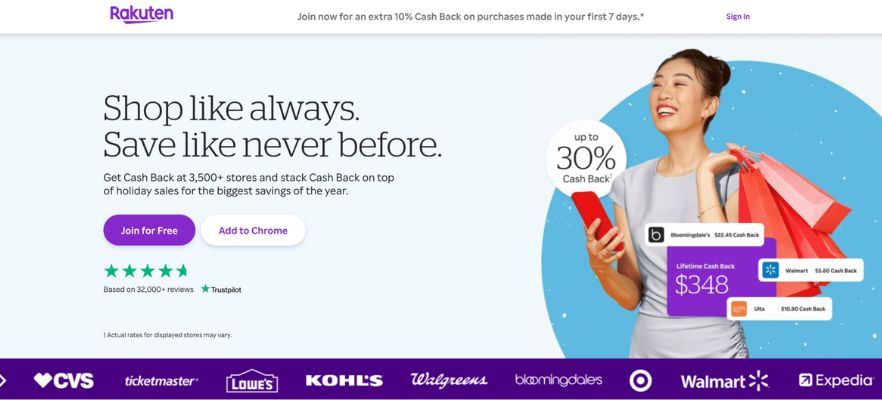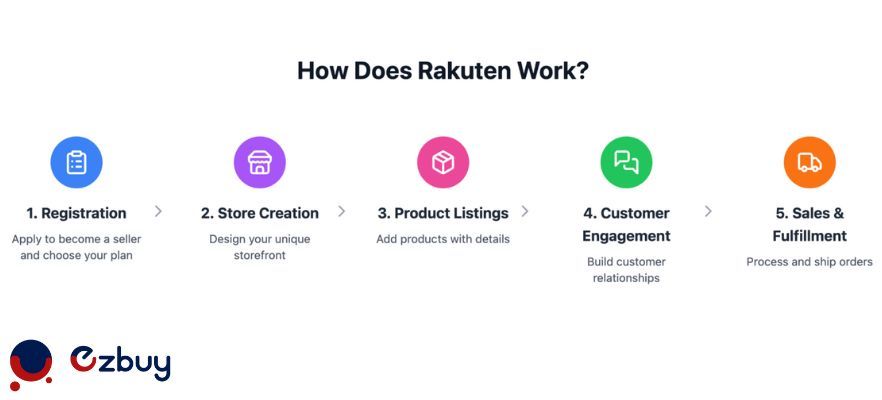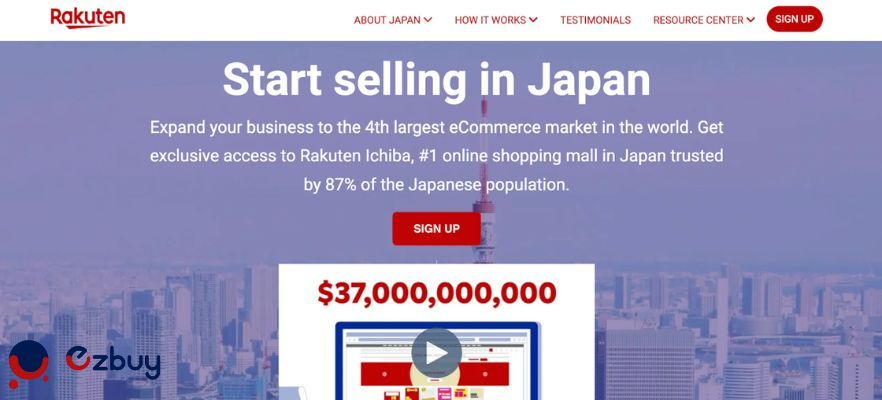How to Sell on Rakuten Marketplace: A Complete 2025 Guide
By Macy -22/01/2025 UTC.
If you're a small business owner, an international brand, or an ecommerce consultant looking to enter the Japanese market, Rakuten might just be the platform you’ve been searching for. Known as Japan’s largest online marketplace, Rakuten offers a unique opportunity to reach millions of high-value consumers. This guide will walk you through everything you need to know to get started to sell on Rakuten Japan, succeed, and grow your presence on Rakuten in 2025.
1. Introduction to Rakuten
1.1. What is Rakuten?
Rakuten is a leading ecommerce platform based in Japan, often called the "Amazon of Japan." Unlike Amazon, which primarily focuses on a direct sales model, Rakuten operates as a marketplace where individual businesses can set up their own online stores. This gives sellers complete control over branding, customer interactions, and marketing.
With over 100 million registered users in Japan alone, Rakuten is more than just an online marketplace, it's a digital ecosystem. It integrates shopping, banking, travel, and entertainment services, offering sellers a unique way to build a loyal customer base through the platform’s popular loyalty program, Rakuten Super Points.

1.2. How Does Rakuten Work?
Rakuten allows sellers to create personalized storefronts to showcase their products. Here’s how the platform works in a nutshell:
- Registration: Businesses must apply to become sellers, meet specific requirements, and choose a subscription plan.
- Store creation: Rakuten offers flexibility in designing your storefront, so this is your chance to build your brand’s identity.
- Product listings: Sellers list products with detailed descriptions, high-quality images, and competitive pricing.
- Customer engagement: Sellers have direct access to customer interactions, enabling them to offer personalized services, respond to inquiries, and build trust.
- Sales and fulfillment: Orders are processed, shipped, and tracked through Rakuten’s integrated system.

Rakuten’s model prioritizes branding and customer loyalty, making it a unique platform for businesses looking to establish a strong presence in Japan.
2. Why Sell on Rakuten?
2.1. Advantages of Selling on Rakuten
Popularity and market share
Rakuten is indeed one of Japan's most popular ecommerce platforms, capturing a significant share of the online shopping market. It holds approximately 25% to 30% of the total ecommerce market in Japan, making it a vital channel for businesses looking to reach Japanese consumers.
Revenue potential
The platform attracts customers who prioritize quality and brand trust, which can lead to higher revenue potential for sellers. Research indicates that consumers on Rakuten are often willing to spend more on products that they perceive as high-quality or from trusted brands.
Customizable storefronts
Unlike many other marketplaces where branding takes a back seat, Rakuten allows sellers to create customized storefronts. This feature enables businesses to establish a unique identity and showcase their brand effectively, enhancing customer engagement. Sellers can design their pages to reflect their brand's aesthetics and values, which is particularly appealing in a market that values brand presentation.
Rakuten Super Points system
The Rakuten Super Points program is a significant loyalty incentive for customers, encouraging repeat purchases. Customers earn points with each transaction, which can be redeemed for discounts on future purchases. This system fosters customer loyalty and enhances long-term relationships between sellers and buyers. The program has proven effective in driving repeat visits and purchases, as evidenced by its widespread use among Japanese consumers.
Seller support and resources
Rakuten provides various resources, training, and tools to help sellers succeed. This includes access to analytics that helps sellers understand customer behavior and sales performance, as well as marketing features that can enhance visibility on the platform. The support offered by Rakuten can significantly reduce the learning curve for new sellers.
2.2. Comparing Rakuten to Other Marketplaces
While platforms like Amazon and eBay focus on low-cost, high-volume transactions, Rakuten emphasizes customer experience and brand building. Sellers have more control over their storefronts, enabling them to craft a unique identity.
Key differences include:
- Branding: Rakuten prioritizes customized store designs; Amazon limits this.
- Customer relationships: Rakuten encourages direct seller-buyer interactions, unlike the more transactional nature of platforms like eBay.
- Loyalty ecosystem: The Super Points system fosters repeat purchases, a feature less prominent on other platforms.
3. Prerequisites to Sell on Rakuten
3.1. General requirements
Business registration
You must have a registered business entity to sell on Rakuten. This could be a sole proprietorship, corporation, or LLC—depending on the rules in your home country.
Tax compliance
Japan’s tax laws apply to all Rakuten sellers. You may need a Japanese tax identification number, especially if you’re selling from outside Japan. Partnering with a tax consultant familiar with Japanese regulations can save you a lot of headaches.
Product categories and restrictions
Rakuten has rules about what you can and can’t sell. Here’s a quick breakdown:
- Allowed categories: Make sure your products fall within Rakuten’s accepted categories.
- Approval required: Certain items, like electronics or health supplements, might need additional certifications or approvals.
- Prohibited items: Counterfeit goods, hazardous materials, or other restricted products are strictly off-limits.
Customer support standards
Rakuten customers expect top-notch service, so you’ll need to meet these standards:
- Respond quickly to customer inquiries—ideally in Japanese.
- If you’re not fluent, using a reliable translation service is highly recommended.
Subscription plans
Rakuten operates on a subscription model, so you’ll need to choose a plan that matches your business goals. Plans range from budget-friendly options for small sellers to premium packages with advanced features.
3.2. Regional considerations to sell on Rakuten
Language matters
Okay, so Rakuten lets you list your products in multiple languages, but here’s the thing: if you want to stand out, go Japanese. Translating your product descriptions, marketing materials, and even customer support into Japanese can really boost your visibility and make local buyers trust you more. It shows you’re serious about doing business in their market.
Shipping and logistics
Shipping is a big deal in Japan. People expect their stuff to arrive quickly and in perfect condition. So, make sure you’re working with a logistics provider who knows how to handle deliveries in Japan. Better yet, check out Rakuten’s recommended fulfillment partners—they’re already familiar with what customers expect.
Cultural adaptation
In Japan, the little details make a big difference. Pay attention to:
- Product presentation: High-quality photos and descriptions are key.
- Packaging: Thoughtful, attractive packaging can set you apart.
- Policies: Clear return and exchange policies help build trust with buyers.
>>> Read more: How To Buy In Rakuten Japan And Ship Overseas
4. Costs and Fees for Selling on Rakuten
Selling on Rakuten involves various costs that depend on the type of subscription plan, product category, and pricing tiers.
4.1. Subscription plans
Rakuten gives you two main options to start:
Starter Plan:
- It’s free—yep, no monthly fee! (0 € per month, excl. VAT)
- But here’s the catch: the commission fees are on the higher side, starting at 16%.
Expert Plan:
- This one costs 49 € per month (before taxes).
- But you get lower commission rates, starting from 10%.
So, if you’re just selling casually, the Starter Plan might work. But if you’re serious about selling a lot, the Expert Plan could save you money in the long run.
4.2. Commission rates (or the cut Rakuten takes)
The commission depends on what you're selling, and here’s how it looks:
- Electronics (Category A):
- Starter Plan: 16%
- Expert Plan: 10%
- Books, Video Games, DIY Tools (Category B):
- Starter Plan: 20%
- Expert Plan: 14%
- Fashion, Jewelry, Toys (Category C):
- Starter Plan: 23%
- Expert Plan: 17%
So, if you’re selling something like electronics, the Expert Plan’s 10% commission might make a big difference in your profits.
4.3. Fixed fees (for each sale)
Rakuten also has a small, fixed fee based on the price of what you’re selling. It’s like a little "per-sale charge." The table table outlines fixed fees per product sold on Rakuten's platform. The fees vary depending on the price of the product sold, excluding VAT (Value Added Tax).

Check this out:
- If your product is under 10 €, the fee is 0.15 €.
- For something around 50 €, it’s 0.50 €.
- Selling a big-ticket item over 400 €? The fee maxes out at 5 €.
These fees aren’t huge, but they add up, so keep them in mind when you’re setting your prices.
Let’s say you sell 50 items in the “less than or equal to 50€” category. Since the fixed fee for this category is 0.50€ per item, your total seller fees for these sales would be:
50 items × 0.50€ = 25€
So, as you can see, if you’re selling just a few items, the Starter Plan is good because it’s free. But if you’re aiming for constant sales or bigger profits, the Expert Plan, with its lower commissions, will probably be worth the monthly fee.
Also, don’t forget about those small fixed fees—they might not seem like much, but when you’re selling lots of products, they’ll affect your bottom line.
5. How to Sell in Rakuten Japan
5.1. Step 1: Registration on Rakuten
Registering your business on Rakuten is the first step, and their onboarding consultants make it easy for you. Head over to Rakuten’s seller registration page and complete the application. You’ll need to provide business details like your tax information, company registration documents, and contact information.
Then, let’s pick a subscription plan that fits your business goals. Once submitted, Rakuten will review your application. This can take anywhere from a few days to a few weeks, depending on your documentation and product category.
5.2. Step 2: Rakuten store setup
After your registration is approved, it’s time to design your store and list your products.
Rakuten allows a lot of customization, so take advantage of it! Use professional images, a clean layout, and a consistent brand theme to attract customers. Make sure your unique selling points are front and center.
Start uploading your products with high-quality images, detailed descriptions, and competitive pricing. Since you’re selling in Japan, present all your product details in Japanese. This helps build trust with local buyers and improves your store’s visibility.
5.3. Step 3: Shop Launch
Once your store is ready, it’s time to launch, but don’t skip these final checks:
- Do a test purchase to ensure the entire customer journey.
- Use Rakuten’s marketing tools, like banner ads, coupons, and Super Points campaigns, to promote your store and attract buyers.
- Launch your shop and keep track on sales performance, customer reviews, and analytics.

6. Major Product Categories to Sell on Rakuten
Understanding which product categories perform best and identifying any restrictions is essential to aligning your offerings with customer demand and Rakuten’s policies.
Note: Rakuten enforces strict policies on prohibited and restricted items to ensure customer safety and compliance with Japanese laws. It’s essential to verify that your products meet the platform’s guidelines before listing.
7. Best Practices to Boost Sales on Rakuten
7.1. Optimize product listings
Your product listings are key to your store’s success. Use high-quality images that show every detail of your products. Write clear and detailed descriptions that include important information like size, material, and how to use the product. Make sure to use simple Japanese language, as this appeals to local customers.
Include relevant keywords to help your products show up in Rakuten’s search results. Highlight what makes your product special, whether it’s high quality, an innovative design, or something exclusive. This can help draw customers to your store.
7.2. Provide competitive shipping options
Shipping is vital for customer satisfaction in Japan. Shoppers expect quick and reliable delivery. Offer affordable or free shipping for orders over a set amount to encourage larger purchases.
Be clear about shipping times and return policies to build trust with customers. Work with logistics providers who know how to deliver in Japan or use Rakuten’s fulfillment services to improve your shipping process.
7.3. Use effective marketing strategies
Marketing is crucial for increasing your visibility on Rakuten. A valuable tool is the Super Points program, where you can give bonus points to encourage repeat purchases. Take advantage of seasonal events like Golden Week or New Year to offer discounts and promotions to attract shoppers.
Consider using Rakuten’s advertising options, such as sponsored ads or banner placements, to keep your store visible against the competition.
>>> Read more: What should be noticed when open online stores in Japan?
8. Let’s Sell on Rakuten with Ezbuy
If you’re an international seller looking to enter Japan’s eCommerce market, Rakuten is a fantastic opportunity—but it does come with its own set of challenges. Luckily, Ezbuy can make the process much easier, allowing you to focus on growing your business while they handle the tricky stuff.
Ezbuy is a global ecommerce solutions provider that helps sellers like you succeed on Rakuten. We take care of logistics, localization, and customer service, so you can hit the ground running.
Here’s how Ezbuy makes selling on Rakuten easier:
Seamless onboarding:
Starting on Rakuten doesn’t have to be complicated. Ezbuy simplifies the seller registration process, ensuring you meet all the necessary requirements. We also guide you in picking the right subscription plan—a crucial first step for new sellers in the Japanese market.
Localization services:
Success in Japan starts with understanding the culture. Ezbuy offers localization services, translating your product listings into Japanese and adjusting your branding to fit local tastes. This helps your products stand out and appeal to Japanese customers.
Logistics and fulfillment
Shipping and inventory can be a headache, especially when navigating Japan’s strict import regulations. Ezbuy takes care of it all, offering affordable shipping solutions while ensuring compliance with local laws. That means fewer delays and happier customers.
Cross-border ecommerce
Ezbuy is a comprehensive solution for cross-border ecommerce, facilitating entry into Japan's competitive market by handling complexities related to logistics, customs clearance, and customer service.
Customer support
Japanese customers value excellent service, and Ezbuy helps you deliver it. We provide Japanese-language support, handle returns, and respond to customer inquiries, ensuring a smooth and professional shopping experience.

9. Sell on Rakuten: FAQs
How much does it cost to sell on Rakuten?
Selling on Rakuten involves three primary costs:
- Subscription fees: €0 - €49/month depending on the plan.
- Commission fees: 10% - 23% based on product category.
- Fixed fees: €0.15 - €5 per product sold.
Can you sell things on Rakuten?
Yes! Rakuten is a marketplace that welcomes sellers from various industries, including fashion, electronics, beauty, and home goods.
How much money can you make on Rakuten?
Your earnings on Rakuten depend on several factors:
- Selling in popular categories like fashion, electronics, or beauty products can generate higher sales.
- Competitive pricing and promotions, such as free shipping or Super Points campaigns, can boost your revenue.
- Building loyalty through Rakuten Super Points and excellent customer service encourages repeat purchases.
- Using Rakuten’s advertising tools effectively can drive traffic to your store and increase sales.
Do you really get money back from Rakuten?
Yes, but this is more about the customers. Rakuten has a cool loyalty program called Rakuten Super Points, where customers earn points every time they make a purchase. They can use those points for discounts on future orders—it’s like getting a little cashback. For you as a seller, being part of this program can help build customer loyalty and encourage repeat business, which is a win-win for your sales.
10. Final Words
Rakuten is a strong entry point for the Japanese eCommerce market, presenting considerable opportunities for brand growth. To sell on Rakuten, optimize your product listings and provide top-notch service. For international sellers, Ezbuy helps with localization, logistics, and compliance, streamlining your market entry. Make Rakuten a key part of your global eCommerce strategy!
Website: https://ezbuy.jp/en